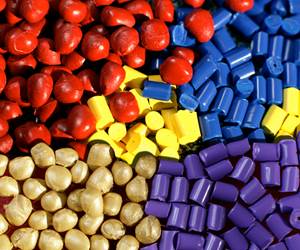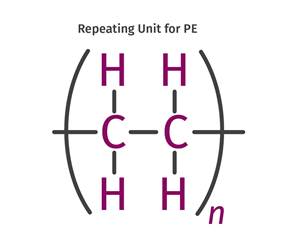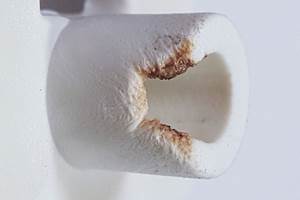Sticking Sprues or Parts? Lots of Possible Causes and Solutions
Material sticking in the mold can be a production killer, whether it is the sprue or the formed part in the cavity.
Material sticking in the mold can be a production killer, whether it is the sprue or the formed part in the cavity. The root causes of such sticking can be traced to one of several equipment or process issues.
Keep in mind that where the part sticks in the mold is not necessarily the area of the mold that is the cause. Different sections of the mold can hang onto the part, and this tug can cause the part to bind in another section. Carefully evaluate what happens as the mold opens.
Equipment fixes
One of the most common causes of sticking is an improper degree of polish. Too high a polish can cause a vacuum to form during molding that holds the part to the steel. On the other hand, too little polish may not allow good part release. If a vacuum is holding the part onto the mold surface, an air pipette may be the answer.
Scratches in the mold or sprue created during use or polishing can cause sticking. Circular polishing can create minute scratches that become undercuts or gouges in the steel that fill with melt. Scratches can cause sticking of the sprue, part sticking on the “A” side of the mold upon mold opening, or part sticking to the “B” side of the mold at part ejection.
To solve sprue sticking, scratches or undercuts can be removed during mold maintenance. In addition, try draw-polishing the mold (i.e., using a back-and-forth motion in the direction of part ejection instead of a circular or elliptical motion) to a number 2 finish. Or try vapor honing (a variation of sandblasting). Vapor honing is better at preventing sticking of soft materials.
When polishing or scratches cause part sticking, you need to determine on which side of the tool the problem lies. If the part sticks on the “A” side, whether that is the stationary or moving mold half or carries the core or cavity, one possible answer is to slowly open the tool under manual control and note any noises or cocking/shifting of the part. If the part is deformed upon mold break, the problem is occurring on the side of the mold that does not eject the part.
If the part adheres to the “B” side, slowly eject the part and note if a corner or section of the part hangs up or shows cocking at this stage.
In either case, possible solutions are draw polishing, removing the undercuts, or using a vapor-honed surface to aid release. Another possible cause of sticking is plate-out on the mold. Inspect the mold surface for build-up and clean if necessary.
Other components in the press or tool can be a source of sticking. A nozzle tip radius that is mismatched with the sprue bushing, or a nozzle tip orifice that is too large can cause sprue problems. Check that the nozzle radius is correct with a simple test. Place a piece of cardboard over the sprue-bushing orifice and press the nozzle tip against the cardboard. The nozzle tip should leave a smooth imprint on the cardboard, indicating a good mating pattern between components. If there are tears or cuts in the cardboard, change the nozzle tip for a better size match. Also check that the nozzle tip is free of burrs and that the nozzle tip orifice is at least 0.030 in. (0.75mm) smaller in diameter than the sprue.
A sprue puller can also be a source of trouble. Be sure it is large enough and properly designed for the application. Adding undercuts, a Z-puller, or more reverse taper can end the problem. Sticking can also be a consequence of too small a taper on the sprue. If the taper is 0.5 in./ft, try increasing it.
Another possible culprit is cocking of the ejector plate. Check for uniform length of the knockout bars, which should be within 0.003 in. of each other.
Another possible source of sticking is a parts-removal robot that distorts or twists the parts. Check the end-of-arm-tooling and the movement of the part on the robot arm.
Process problems
Several processing missteps can cause sticking of the sprue or part. Unbalanced filling, especially in a multi-cavity tool, can cause over- or underpacking and subsequent part sticking. A test of mold-filling balance is one way to confirm or eliminate this factor.
Overpacking is the major process-related cause of sprue sticking. If some plastic remains stuck in the sprue channel, the next injection cycle will cause extremely high packing pressures, preventing normal shrinkage of the sprue that allows for release. So more sticking will result. The sprue can also be overpacked by high backpressure during screw recovery.
If overpacking is the cause, run tests to determine the gate-seal time and then run the part with the gate sealed and gate unsealed. Determine whether the difference in pack/hold time makes a difference in sticking.
Packing can also be related to part sticking. Overpacking the mold with melt can result in too little shrinkage of the part, making ejection difficult. Reducing the pack or hold pressure (or time) is one solution to try. Pressure and time taken from the second-stage pack and hold should be added to the cooling or cure.
Note that underpacking the mold can cause excessive shrinkage onto cores, which can also result in sticking. Here, molders should increase the second-stage pack/hold time and pressure while decreasing cooling time to maintain the same overall cycle time. Sometimes it helps to reduce the cooling time to minimize shrinkage onto a core. But extending the overall cycle time by lengthening the cooling time can work also if you need more time for the part to shrink away from a cavity onto a core.
Mold or material temperature can also be a source of sticking problems. Degraded materials tend to stick, so check to see that the process temperatures are correct, especially at the nozzle, where both setpoint and actual temperatures need to be controlled tightly. Molders have considerable leeway to raise or lower the mold temperature, as long as it does not cause mold damage. But also check the water flow rate in mold-cooling lines to make sure that you achieve a Reynold’s number of 5000 or greater for turbulent flow and optimal cooling. The temperature difference between the inlet and outlet water lines should be less than 4° F.
Crazing of the part surface can also be a sign of the cause of sticking. Look for symptoms in the area of the part that is sticking, such as stress-whitening near ejector pins. Then check the tool for a source of stress on the part in those areas. Make sure the crazing is not caused by residual cleaning solvents or mold sprays that can attack certain resins.
A sprue that is too soft or not frozen can cause sticking. You can try to downsize the sprue, or cool the sprue bushing, or try lowering the nozzle or melt temperature. A last resort is to increase the cooling time.
Last, but not least, check whether there is mold release agent in the resin, and what kind. Try adding more or changing to a different type or grade.
John Bozzelli has taught seminars on plastics design and processing for more than 20 years. He has extensive experience in polymer development and processing from more than 20 years with Dow Plastics. He is the founder of Injection Molding Solutions/Scientific Molding in Midland, Mich., a provider of in-plant training and consulting services. Tel: (998) 832-2424 or e-mail: John@scientificmolding.com
Related Content
Fundamentals of Polyethylene – Part 6: PE Performance
Don’t assume you know everything there is to know about PE because it’s been around so long. Here is yet another example of how the performance of PE is influenced by molecular weight and density.
Read MoreThe Fundamentals of Polyethylene – Part 2: Density and Molecular Weight
PE properties can be adjusted either by changing the molecular weight or by altering the density. While this increases the possible combinations of properties, it also requires that the specification for the material be precise.
Read MoreBack to Basics on Mold Venting (Part 1)
Here’s what you need to know to improve the quality of your parts and to protect your molds.
Read MoreInjection Molding: Focus on these Seven Areas to Set a Preventive Maintenance Schedule
Performing fundamental maintenance inspections frequently assures press longevity and process stability. Here’s a checklist to help you stay on top of seven key systems.
Read MoreRead Next
Beyond Prototypes: 8 Ways the Plastics Industry Is Using 3D Printing
Plastics processors are finding applications for 3D printing around the plant and across the supply chain. Here are 8 examples to look for at NPE2024.
Read MorePeople 4.0 – How to Get Buy-In from Your Staff for Industry 4.0 Systems
Implementing a production monitoring system as the foundation of a ‘smart factory’ is about integrating people with new technology as much as it is about integrating machines and computers. Here are tips from a company that has gone through the process.
Read More.jpg;width=70;height=70;mode=crop)












